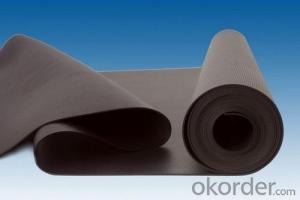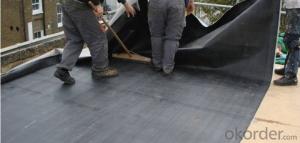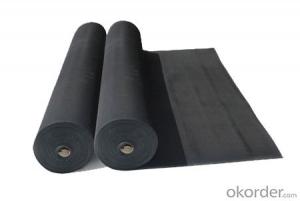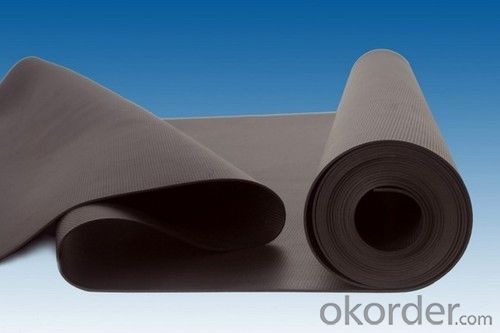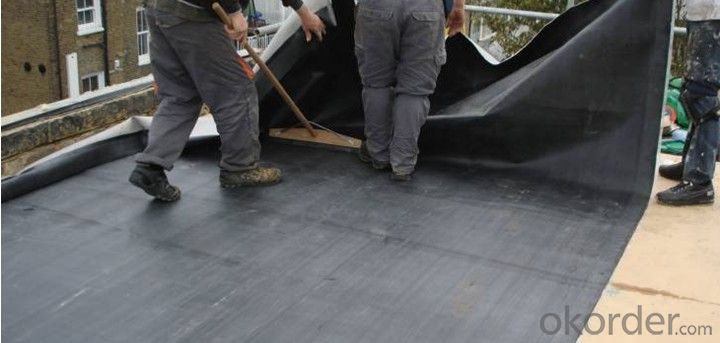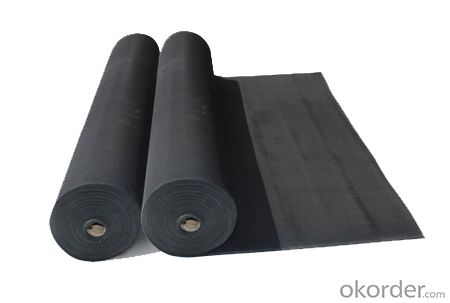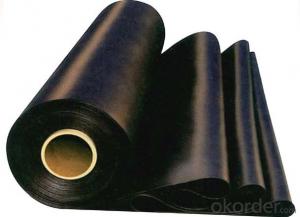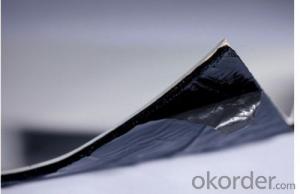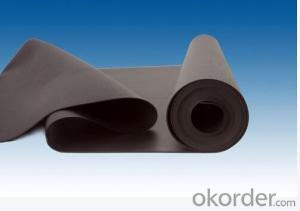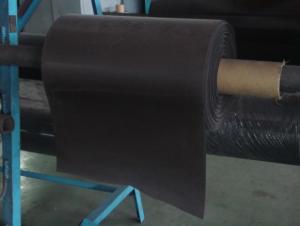EPDM Waterproofing Membrane for Underground Roof
- Loading Port:
- China main port
- Payment Terms:
- TT OR LC
- Min Order Qty:
- 5000 m²
- Supply Capability:
- 100000 m²/month
OKorder Service Pledge
OKorder Financial Service
You Might Also Like
Introduction for EPDM Waterproofing Membrane:
This waterproof coiled material is of high elasticity with best performance among high polymer waterproof coiled material in the world.It is also the most typical one in the world.Waterproof coiled material made of ternary ethylene-propylene rubber is produced with the use of the most advanced continuous extrusion and vulcanization technology and related equipments which are specially designed for production of such product.It is good in compactness,without bubble and performance difference in length and breadth,performances reach or exceed the demands.
Characteristic of EPDM Waterproofing Membrane:
1>Excellent anti-aging performance, service life up to 50 years
2>Working well with in -40°C to 100°C,it can be constructed with a single layer in ambient temperature. 3>Waterproofing on various kinds of underground project,industrial of civil buildings and structures. 4>high extension rate, high tensile strength, small size changes at heat treatment
5>Good plant roots penetrability resistance and can be made waterproofing layer of planting roof
6>Special modified molecular structure ,effectively resolving the current domestic and foreign glue joint problem . 7>Good low temperature flexibility, and good performance of adapting to ambient temperature changes. 8>Convenient application ,solid joint, no environment pollution
9>chemical corrosion Resistance, can be used for special occasions
Usesage of EPDM Waterproofing Membrane:
Widely used in roofs, basement, toilet ,swimming pool, and all kinds of industry and civil building waterproofing, reservoir, bridge, underground, tunnel and dam waterproofing ,especially to the keystone waterproofing projects which is durability, high corrosion resistance and easy deformation
Item | Thickness(mm) | Width(mm) | Length(m) | Color |
1.0—2.0 | 1200 | 20 | Black | |
Deviation | -1 +15 | --1 | Multicolor |
FAQ of Waterproofing Membrane
a.Can we get some samples before place order?
Answer: We can send the free samples to you by freight collect.
b.How many years can your PVC membrane guarantee?
Answer: We will guarantee the quality for 5 years at least.
c.Which countries you ever export the product?
Answer: We export the PVC membrane to South Africa, Middle east and even European countries.
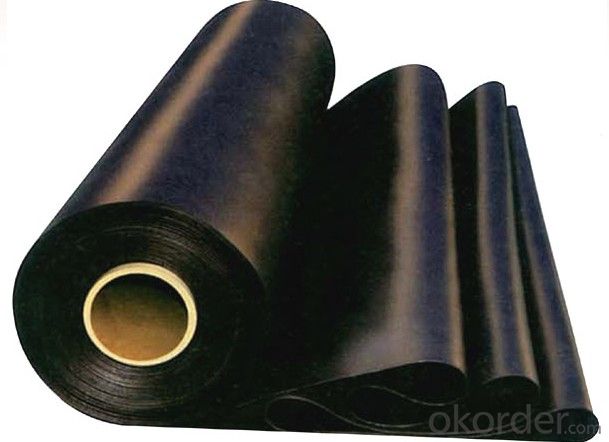
- Q: Can a waterproofing membrane be used on cement board surfaces?
- Yes, a waterproofing membrane can be used on cement board surfaces. Cement board is a commonly used material in construction, particularly in areas prone to moisture such as bathrooms and kitchens. While cement board itself is water-resistant, it is not completely waterproof. Therefore, using a waterproofing membrane can provide an additional layer of protection against water damage. A waterproofing membrane is a thin layer of material that is applied to the surface of the cement board. It is designed to prevent water from penetrating the board and reaching the underlying structure. This is especially important in areas where water exposure is frequent, such as shower stalls or backsplashes. There are different types of waterproofing membranes available, including liquid-applied membranes and sheet membranes. Liquid-applied membranes are typically applied with a brush or roller, while sheet membranes are rolled onto the surface and adhered using an adhesive or thinset mortar. When applying a waterproofing membrane to a cement board surface, it is important to follow the manufacturer's instructions and ensure proper adhesion. This may involve cleaning and priming the surface beforehand, as well as allowing sufficient drying time between coats. In conclusion, using a waterproofing membrane on cement board surfaces can help protect against water damage and prolong the life of the construction. It is a recommended practice, especially in areas prone to moisture, and can provide added peace of mind for homeowners and contractors alike.
- Q: Are there any specific considerations for installing a waterproofing membrane on precast concrete surfaces?
- Yes, there are specific considerations for installing a waterproofing membrane on precast concrete surfaces. Here are a few key points to keep in mind: 1. Surface Preparation: Before applying the waterproofing membrane, it is crucial to prepare the precast concrete surface properly. This may involve cleaning the surface, removing any loose particles, and ensuring that it is dry and free from any contaminants. 2. Compatibility: It is important to choose a waterproofing membrane that is compatible with precast concrete surfaces. Some membranes may not adhere well or may not provide effective waterproofing on this type of substrate. Therefore, it is essential to select a membrane specifically designed for use on precast concrete. 3. Adhesion: Ensuring proper adhesion of the waterproofing membrane to the precast concrete surface is vital. The manufacturer's instructions should be followed carefully, including any surface priming or preparation requirements for optimal adhesion. Proper adhesion will help prevent any water infiltration or damage to the concrete. 4. Joint Treatment: Precast concrete surfaces often have joints between panels or other components. These joints need to be properly treated to maintain the waterproofing integrity of the system. This may involve using joint sealants or tapes specifically designed for waterproofing purposes. 5. Durability: Consider the durability and longevity of the waterproofing membrane. Precast concrete surfaces are often exposed to various weather conditions and environmental factors. Therefore, it is crucial to select a membrane that can withstand these conditions and provide long-term protection against water penetration. 6. Quality Assurance: It is recommended to work with experienced professionals or certified installers to ensure the proper installation of the waterproofing membrane on precast concrete surfaces. This will help to minimize any potential installation errors and ensure that the waterproofing system performs as intended. By considering these specific considerations, the installation of a waterproofing membrane on precast concrete surfaces can help protect the concrete from water damage and extend its lifespan.
- Q: Sbs waterproof sheet and app coil how to see it
- SBS full name is: styrene - butadiene - styrene block copolymer. SBS is an abbreviation of elastomer modified asphalt waterproofing membrane. It is also known as SBS modified asphalt waterproofing membrane. It is made of polyester felt, fiberglass felt or glass fiber reinforced polyester felt as the base, styrene-butadiene (SBS) thermoplastic elastomer as a petroleum asphalt modifier, both sides covered with isolation materials made of building waterproofing membrane, the product implementation of the standard GB18242 national mandatory standards. Product markings are carried out according to the following procedures: name, model, tire base, upper surface material, lower surface material, thickness, area and this standard number, for example: 3mm thick, 10㎡ area, the upper surface is mineral pellets, the lower surface is poly Vinyl film, polyester tread base, type I elastomer modified asphalt waterproofing membrane marked as: SBS I PY M PE 3 10 GB18242-2008.
- Q: Can a waterproofing membrane be used for a swimming pool?
- Indeed, a swimming pool can benefit from the utilization of a waterproofing membrane. In the realm of construction, waterproofing membranes find frequent application in order to avert water infiltration and leakage. Once administered to both the walls and floor of a swimming pool, a waterproofing membrane establishes a protective barrier that thwarts the infiltration of water into the adjacent structures. This essential measure is imperative for upholding the pool's integrity and averting harm to the surrounding regions. Tailored specifically for swimming pools, waterproofing membranes are engineered to endure the perpetual exposure to water and chemicals, guaranteeing durable safeguarding.
- Q: Can a waterproofing membrane be applied on both interior and exterior surfaces of a structure?
- Both interior and exterior surfaces of a structure can receive the application of a waterproofing membrane. These membranes are designed to form a barrier that prevents water from infiltrating the structure. Regardless of whether it is applied internally or externally, the membrane serves the same purpose of keeping water out and safeguarding the structure against moisture damage. In the case of basements, crawl spaces, or other areas where water intrusion from the inside is a worry, interior waterproofing membranes are typically utilized. On the other hand, exterior waterproofing membranes are commonly used on foundation walls, below-grade areas, or building envelopes to stop water from seeping into the structure. It is crucial to select the appropriate type of waterproofing membrane based on the specific requirements and conditions of the structure.
- Q: Are there any specific maintenance requirements for a waterproofing membrane?
- Yes, there are specific maintenance requirements for a waterproofing membrane. Regular inspections should be conducted to check for any signs of damage or deterioration, such as cracks or leaks. Any debris or standing water should be promptly removed to prevent potential damage. Additionally, it is important to follow the manufacturer's guidelines for cleaning and maintenance, which may include periodic cleaning with mild detergents and avoiding the use of harsh chemicals or abrasive cleaning tools.
- Q: Can waterproofing membranes be used on stormwater management systems?
- Yes, waterproofing membranes can be used on stormwater management systems. Waterproofing membranes are commonly used to prevent water infiltration and protect structures from water damage. In the case of stormwater management systems, which are designed to capture, store, and manage rainwater runoff, waterproofing membranes can be used to create a watertight seal and prevent leaks or seepage. Stormwater management systems often include components such as retention ponds, infiltration basins, or underground storage systems. These components need to be properly sealed to ensure that the collected stormwater is contained and managed effectively. Waterproofing membranes, when installed correctly, can provide an impermeable barrier that prevents water from escaping or infiltrating the system. Using waterproofing membranes on stormwater management systems offers several benefits. Firstly, it helps to maintain the integrity and functionality of the system by preventing leaks or seepage that may compromise its performance. This ensures that the stormwater is effectively captured and managed, reducing the risk of flooding or erosion. Additionally, waterproofing membranes can extend the lifespan of stormwater management systems by protecting them from water damage. Water infiltration can lead to structural deterioration, corrosion, or the growth of mold and mildew, which can all weaken the system over time. By creating a waterproof barrier, the membranes help to preserve the structural integrity of the components, increasing their longevity and reducing maintenance requirements. Furthermore, using waterproofing membranes on stormwater management systems can also contribute to environmental sustainability. By effectively containing and managing stormwater runoff, these systems help to reduce water pollution and improve the quality of natural water bodies. Waterproofing membranes play a crucial role in preventing stormwater from carrying pollutants, such as chemicals or sediment, into rivers, lakes, or oceans. In summary, waterproofing membranes can be used on stormwater management systems to create a watertight seal, prevent leaks, and protect the components from water damage. By providing an impermeable barrier, these membranes help to maintain the functionality and integrity of the system, extend its lifespan, and contribute to environmental sustainability by reducing water pollution.
- Q: Can a waterproofing membrane be used on below-grade walls?
- Indeed, a waterproofing membrane is capable of being employed on walls located below ground level. In fact, it is highly advisable to utilize a waterproofing membrane on such walls so as to shield them against infiltration of water and potential harm caused by moisture. Walls situated below ground level are especially susceptible to water penetration due to their proximity to the ground and the possibility of hydrostatic pressure. A waterproofing membrane serves as a protective barrier, effectively preventing water from seeping into the walls and leading to issues such as mold, mildew, decay, and structural impairment. Moreover, it aids in maintaining the interior of the edifice in a dry condition, thereby averting potential problems related to moisture.
- Q: Can a waterproofing membrane be installed in areas with high humidity?
- Installing a waterproofing membrane is possible in areas with high humidity. In fact, high humidity can contribute to the necessity of waterproofing due to the possibility of moisture accumulation and potential water damage. Regardless of the humidity levels, waterproofing membranes are designed to establish a barrier against water infiltration. Nonetheless, it is crucial to guarantee the correct installation and sealing of the membrane to prevent any moisture seepage. Moreover, in areas with high humidity, it might be essential to adopt additional measures like utilizing moisture barriers or dehumidifiers to provide further protection against potential water damage.
- Q: Are waterproofing membranes resistant to hydrocarbons?
- Yes, waterproofing membranes are generally resistant to hydrocarbons. They are designed to provide a barrier against water and other liquids, including hydrocarbons, preventing them from penetrating through the membrane and causing damage to the underlying structure.
Send your message to us
EPDM Waterproofing Membrane for Underground Roof
- Loading Port:
- China main port
- Payment Terms:
- TT OR LC
- Min Order Qty:
- 5000 m²
- Supply Capability:
- 100000 m²/month
OKorder Service Pledge
OKorder Financial Service
Similar products
Hot products
Hot Searches
Related keywords
